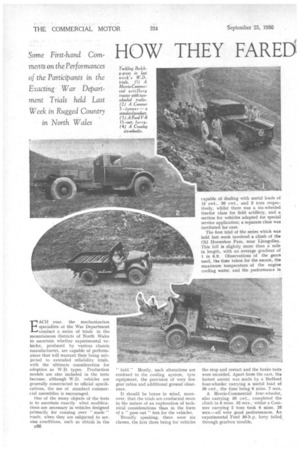HOW THEY FARED N THE W.D. TRIALS
Page 110

Page 111

If you've noticed an error in this article please click here to report it so we can fix it.
Some First-hand Comments on the Performances of the Participants in the Exacting War Department Trials held Last Week in Rugged Country
in North Wales
EACH year, the mechanization conduct a series of trials in the specialists at the War Department mountainous districts of North Wales to ascertain whether experimental vehicles, produced by various chassis. manufacturers, are capable of performances that will warrant their being subjected to extended reliability trials, with the ultimate consideration for adoption as WEE types. Production models are also included in the tests because, although W.D. vehicles are generally constructed to official specifications, the use of standard commercial assemblies is encouraged.
One of the many objects of the tests is to ascertain exactly what modifications are necessary in vehicles designed primarily for running over " made" roads, when they are subjected. to service conditions, such as obtain in the
c60
" field." Mostly, such alterations are confined to the cooling system, tyre equipment, the provision of very low gear ratios and additional ground clearance.
It should be borne in mind, moreover, that the trials are conducted more in the nature of an exploration of technical considerations than in the form of a " pass out " test for the vehicles.
Broadly speaking, there were six classes, the first three being for vehicles capable of dealing with useful loads of 15 cwt., 30 cwt., and 3 tons respectively, whilst there was a six-wheeled tractor class for field artillery, and a section for vehicles adapted for special service application; a separate class was instituted for cars.
The first trial of the series which was held last week involved a climb of the Old Horseshoe Pass, near Llangollen. This hill is slightly more than a mile in length, with an average gradient of 1 in 6.9. Observations of the gears used, tips time taken for the ascent, the maximum temperature of the engine cooling water, and the performance in the stop and restart and the brake tests were recorded. Apart from the cars, the fastest ascent was made by a Bedford four-wheeler carrying a useful load of 30 cwt., the time being 6 mins. 7 secs.
A Morris-Commercial four-wheeler, also carrying 30 cwt., completed the climb in 6 mins. 32 secs., whilst a Commer carrying 2 tons took 6 mins. 26 secs.—all very good performances. An experimental Ford 30-h.p. lorry failed through gearbox trouble.
Among the 3-tonners the A.E.C., Crossley, Leyland, and Thornycroft all climbed steadily with power in hand. A notable newcomer was a Thornycroft with an oil engine; this particular vehicle made the fastest climb in the " heavies " and was distinctive in that the exhaust was clear, even when pulling hard on the steepest part.
During the ascent the first brake test revealed the fact that since the trials held last year, all-round improvements had been effected. In every case, except a somewhat overloaded TillingStevens petrol-electric vehicle drawing a trailer, both hand and foot brakes separately held the vehicles on the steepest part (gradient 1 in 4.87).
A cross-country run over gullies and soft ground showed that the sixwheeled machines held immeasurable advantage over the normal fourwheeler. Many vehicles of the former type simply ploughed their way along over hummocks and ditches which brought the other types to a halt.
The comparatively clean sheet of the vehicles on the Old Horseshoe Pass was reversed when they were put at Alt-yBady, a steep incline with a good surface which could not, however, be termed thoroughly satisfactory. The hill is ,89 mile long and has a maximum gradient of 1 in 3.38, the average incline working out at 1 in 6.69. The Bedford and Morris-Commercial 30cwt. models made relatively easy ascents, likewise the A.E.C. Marshall, the Crossley, the Morris-Commercial Leader, the Leyland Cub, and the Thornycroft. The Commer failed due to wheel spin. the Ford, Tatra, Guy, Ford-Unipower and the Tilling-Stevens petrol-electric did not attempt the climb. Only one of the cars (the li-litre Riley) succeeded in making an unassisted ascent, whilst a Gilford, equipped with a High Speed suction-gas plant, also just failed.
The final test Was carried out on BwIch-y-groes, a well-known testing ground for cars and motorcycles. This hill is 1.55 mile long, rising 738 ft. per mile, with an average gradient of 1 in 7.1. In addition to the observations of features of the climb, both hand and foot brakes were tested near the top where the gradient is 1 in 4. The best time in the freight-vehicle class was that of the Morris-Commercial Leader which, carrying 2 tons, completed the ascent in 9 mins. 10 secs. Next came the Bedford, carrying 30 cwt., which recorded 9 mins. 17 secs., whilst the Commer also made a good ascent in 10 mins. The " heavies " with very-low gear ratios, afforded by auxiliary gearboxes, made steady ascents with power in hand. The performance of the Thornycroft was outstandingly good; it completed the ascent in 16 mins. 3 secs.
The final brake test on Bwlch-y-groes actually determined the capacity of the machines to withstand arduous conditions. The experimental Ford, the Tatra and the Guy did not attempt it. All the other vehicles which made a full-scale climb were able to maintain their position on the 1 in 4 gradient with either brake alone.
























































































































































